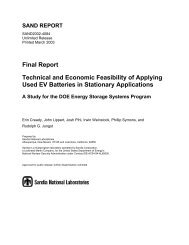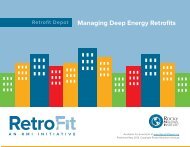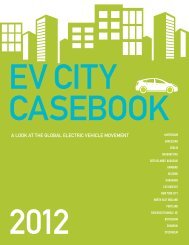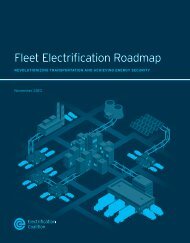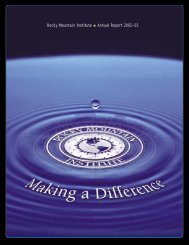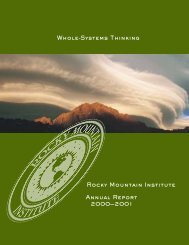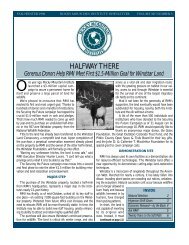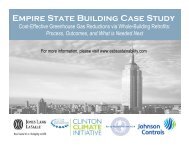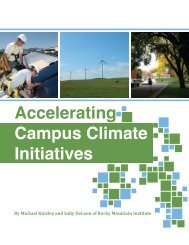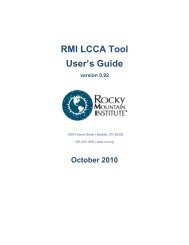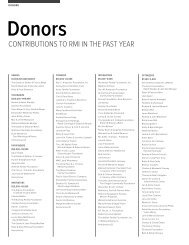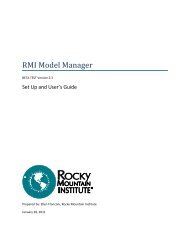Abundance by Design - Rocky Mountain Institute
Abundance by Design - Rocky Mountain Institute
Abundance by Design - Rocky Mountain Institute
- No tags were found...
Create successful ePaper yourself
Turn your PDF publications into a flip-book with our unique Google optimized e-Paper software.
Winning the Oil EndgameIN 2002–03, ROCKY MOUNTAIN INSTITUTEsaw the “avoidable oil crisis” we’d been warningabout for decades becoming imminent, so welaunched a detailed effort to discover how much U.S.oil use could be profitably saved or displaced. Theanswer: all, cheaper than buying oil for $26 per barrel(the U.S. government’s 2004 forecast of world oilprice in 2025, all in year-2000 $).In 1850, whaling was one of America’s largestindustries, and whale-oil lamps lit most homes.But as whales became shy and scarce, whale oilprices elicited competitors that grabbed more thanfive-sixths of that lighting market in the nine yearsbefore Drake struck oil in 1859. The inattentivewhalers were astounded.Oil is now poisedto repeat that history.A nearly two-yearand million-dollar effort<strong>by</strong> five RMI coauthors,scores of staff, and hundredsof peer reviewersand advisors showedhow. On 20 September2004, RMI publishedits oil solution: an independent,comprehensive319-page study ofhow to get the U.S. completelyoff oil and revitalizethe economy, led <strong>by</strong> business for profit.By the 2040s, we found, the U.S. could redoubleits efficiency of using oil (already doubled since1975) at an average cost of $12 per saved barrel.At an average cost of $18 per barrel, saved naturalgas and advanced biofuels (mainly ethanol madefrom woody, weedy plants like switchgrass andpoplar) could replace the rest. The best technologiesin or entering commercial service in 2004could profitably triple the efficiency and improvethe safety of cars, trucks, and planes, with all thesize and performance officially projected for 2025.The transition would require a $180-billion investment—halfto retool the car, truck, and plane industries,half to build an advanced biofuels industry.Returns <strong>by</strong> 2025: $155 billion annual gross savings,$70 billion annual net savings, a million new jobs, amillion existing jobs saved, 26 percent lower carbondioxide emissions, and a safer world, all driven <strong>by</strong>business logic. Aligning public policy would make thetransition faster, smoother, and less risky—withoutfuel taxes, subsidies, mandates, or new federal laws.A year ago, we launched Winning the Oil Endgameat the National Press Club, Resources for the Future,the National Defense University, the Center forStrategic and International Studies, and the Councilon Foreign Relations (whose Energy Security Groupchairman called it “one of the most important energystudies in decades”). So what’s happened? More than150,000 people have visited www.oilendgame.com;many have downloaded the book gratis. Web postingof all sources and spreadsheets forestalled analyticalchallenges. The study’s apolitical content and tone,eloquent forewords <strong>by</strong> George Shultz and formerShell Chairman Sir Mark Moody-Stuart, and cosponsorship<strong>by</strong> the Office of the Secretary of Defense andthe Chief of Naval Research all broadened credibility.Winning the Oil Endgame was featured in the WallStreet Journal (<strong>by</strong> President Reagan’s National SecurityAdvisor, Robert C. McFarlane), Fortune, Time (“one ofthe best analyses of energy policy yet produced”),Newsweek International, BusinessWeek Online, RiponForum, and Worth; favorably covered <strong>by</strong> theEconomist, New York Times, Los Angeles Times, DailyTelegraph, Foreign Affairs, MSN Money, and others;and presented to more than forty important industry,policy, and scientific conferences. There’s growingpolitical interest at national, state, and internationallevels. And the message is resonating strongly with itsintended audiences—business and military leaders.Since launch, problems in both the Persian Gulf andthe Gulf of Mexico have boosted oil prices and heightenedthe need for dramatic technological and policyinnovation. Most Americans realize that a country thatuses 25 percent of the world’s oil, produces 9 percent,and owns 2 percent can’t drill its way out. Now comesthe hard part: playing the oil endgame to win.Our proposed policies are novel, light-handed, andmarket-oriented. For example, at our suggestion, theDistrict of Columbia has adopted the functional equivalentof a “feebate”—making efficient vehicles cheaperand inefficient ones costlier (best done in each sizeclass), so buyers consider lifecycle fuel savings, not justthe first 2–3 years’ worth. This illustrates how statescan innovate without federal leadership or hindrance.But the main leadership will come from business.At mid-2005, RMI’s “off-oil” team was refining athree-year, $4-million plan to tweak precise4



